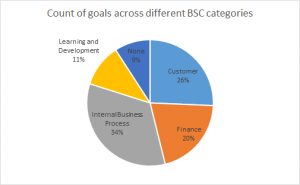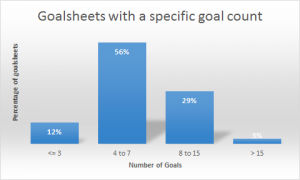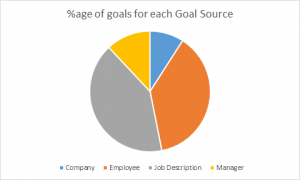An excellent article on Forbes Why You Should Be Writing Down Your Goals says that most of us don’t have a clear idea on how to write goals and hence don’t spend time in writing them down. There are over 84% employees who do not write goals and hence there is a significant loss of productivity, transparency and focus. While discussing this with a colleague, who represents senior management in a mid-sized organization, I was told that most people are fairly good in setting goals for themselves but are fairly unclear on setting goals at an organization level. On discussing further, I could see that there were many questions in his mind around baselining his goal setting process and he had basic questions around
- » What should be the focus areas
- » How to decide on the priority
- » How to have uniform goal standards
- » What should be the involvement of managers (and employees in the process)
This post analyzes data across 85,000 goal-sheets and over 900K goals to derive insights into the questions above. It will help you understand how other companies are managing their goalsetting process and aligning employees to common objectives. This may also give you greater clarity in baselining your goal setting process.
What should be the Focus Area of Goals
For each goal that is set in empxtrack, we offer an option called Categorization. There were over 400 different categories identified in the product and were mapped by our analytics team to the standard Balanced Score Card Categories viz. Finance, Customer, Internal Business Process and Learning and Development. In addition, many organizations have an option of not forcing a category so we identified a No Category option.
The chart indicates the split of the goals across the balanced score card categories and will help us analyze the focus areas of the organizations.

The above chart tell us about the percentage of goals for each balanced score card category. Over one-third of the goals in organizations are focused on Internal business processes and there is a 20% to 25% focus on Customer and Finance related goals. Companies are putting a 10% weight on learning and development indicating a strong need in companies to focus on employee development.
What is the ideal number of goals in the goalsheet?
It is said that the ideal number of goals in a goalsheet should be between 5 and 7. This allows the identification of a clear action plan and can ease the employee-manager discussions.
Our analysis revealed as small as 2 goals in a goalsheets and as high as 55 goals in a single goalsheet. The spread of the goals was as follows

The above chart indicates that over 50% goalsheets have between 4 and 7 goals.
What should be the weight of goals in the goalsheet
While analyzing goal weights we found an even greater variation in comparison to the number of goals chart drawn above. Goal weights varied between 0 and 75 and the following chart displays the %age of goals in each range of weights.
Over 50% of the goals had a weight of less than 10 .


If we refer to the balanced score card categories again to see what is the total weight of goals for each category, the results are not too surprising. The data maps to the count of goals for each category as displayed above with minor variations in weights.
Who defines the goals for employees or what should be the goal source?
There could be various ways in which a goal can be defined.
- » The employee themselves
- » Organization and department goals
- » Job Descriptions
- » Managers and others
We were surprised to find that the biggest percentage of goals were defined by using the Job descriptions. This trend on the use of job descriptions indicates that there is significant standardization in the goals allocation process across the organizations.
The second largest segment was employees defining goals for themselves and their managers approving the same. This indicates that many organizations are empowering their employees to set goals for themselves.

Empxtrack can help organizations in managing their goal setting process.









Great article. Thanks for the detailed information. Your blog is by far the best source I’ve found. Thanks!